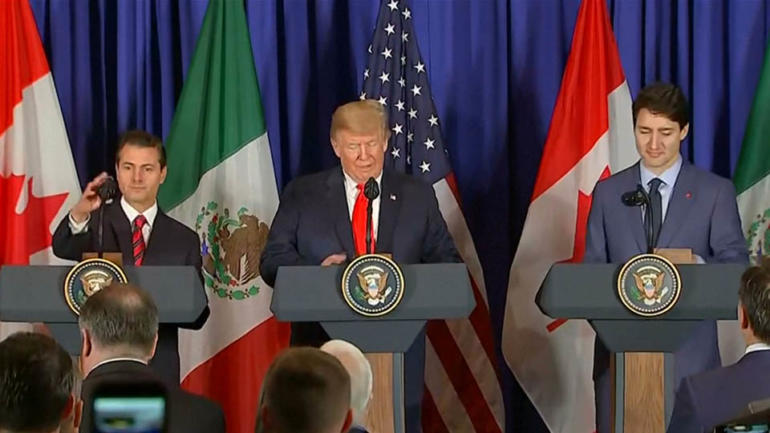The leaders of Canada, Mexico and the United States have signed the replacement for the North American Free Trade Association, NAFTA.
Donald Trump said the U.S Mexico Canada Agreement is much better than its predecessor.
But one of his key partners isn’t so sure.
CGTN’s Owen Fairclough has more.
A new chapter in North American trade signed in southernmost South America at the G20 summit – the U.S. Mexico Canada Agreement signed by their respective leaders.
U.S. President Donald Trump told a news conference in Buenos Aires: “This is a model agreement that changes the trade landscape forever and this is an agreement that first and foremost benefits working people.”
USMCA replaces the North American Free Trade Agreement that transformed the trade of everything from avocado to the zacaton root used to make brushes
Trump claimed NAFTA put Americans out of work with unfair trade practices, calling it “one of the worst deals ever made.”
So how different is USMCA?
“The goal of the Trump administration is to bring back auto manufacturing to the United States,” Simon Lester, director of the CATO Institute Herbert A. Stiefel Center for Trade Policy Studies said.
And that means increasing how much of a vehicle’s content must be made in its country of origin.
Under NAFTA it was just over 60 percent —now it’s 75 percent.
When NAFTA took effect during the early days of the internet in 1994 there were no e-commerce rules.
USMCA has a whole chapter on it.
And NAFTA all but fenced off Canada’s dairy industry from competition. Now U.S. rivals will have greater access to its market.
But if Trump said he’s protecting American auto workers, Canadian Prime Minister Justin Trudeau was quick to remind him in Argentina that automaker GM had only a few days ago announced it’ll cut around 14,000 jobs in the U.S. and Canada.
“The recent plant closures by General Motors, which affects thousands of Canadian and American workers and their families, are a heavy blow,” said Trudeau.
“Make no mistake, we will stand up for our workers and fight for their families and their communities, and Donald, it’s all the more reason why we need to keep working to remove the tariffs on steel and aluminum between our countries.”
And while Mexico expects those metal tariffs to be lifted now this new deal is in place, it isn’t clear when that might happen for Canada.
It appears there are limits to free trade, two words that are conspicuously absent from USMCA’s title.
USMCA took more than a year of acrimonious negotiations and has to be ratified by each country’s legislature. And there’s a crucial get-out demanded by the U.S— a sunset clause that means USMCA is up for renegotiation in 16-years’ time.
 CGTN America
CGTN America

